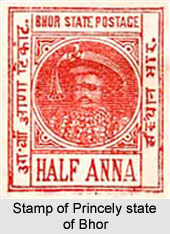 The Princely State of Bhor was under the Poona (Pune) Political Agency of the Bombay Presidency during the British rule in India. The state was later under the Deccan States Agency. At present, Bhor is a municipal council in the district of Pune in Maharashtra state. Bhor state was one of the Satara Jagirs along with Jath State, Phaltan State, Aundh State and the princely state of Akkalkot. The princely state of Bhor was spread over an area of 2,357 sq km and was located in the higher peaks of the Western Ghats. The total population of the territory was around 137, 268 during the year 1901. The Hindu rulers of the Bhor state belonged to the Deshastha Brahmin caste, the oldest Hindu Brahmin sub-caste mainly from Maharashtra state; and had the official title Pantsachiv. The rulers of the princely state of Bhor were entitled to a hereditary 9 gun salute. The official flag of the state was a red swallow-tailed pennant.
The Princely State of Bhor was under the Poona (Pune) Political Agency of the Bombay Presidency during the British rule in India. The state was later under the Deccan States Agency. At present, Bhor is a municipal council in the district of Pune in Maharashtra state. Bhor state was one of the Satara Jagirs along with Jath State, Phaltan State, Aundh State and the princely state of Akkalkot. The princely state of Bhor was spread over an area of 2,357 sq km and was located in the higher peaks of the Western Ghats. The total population of the territory was around 137, 268 during the year 1901. The Hindu rulers of the Bhor state belonged to the Deshastha Brahmin caste, the oldest Hindu Brahmin sub-caste mainly from Maharashtra state; and had the official title Pantsachiv. The rulers of the princely state of Bhor were entitled to a hereditary 9 gun salute. The official flag of the state was a red swallow-tailed pennant.
The princely state of Bhor was founded by Shankarji Narayan, who became the Pantsachiv, one of the 8 hereditary ministers by Rajaram Chhatrapati in the year 1697. On 8th March 1948, Bhor was acceded to the Union of India. Raja Shrimant Sir Raghunathrao Shankarrao Babasaheb Pandit Pantsachiv was the last ruler of Bhor state. The town of Bhor was the capital of the princely state and is situated almost 51 km south of Pune, near to Bhatghar Dam.
Bhor was one of the most prominent princely states during the rule of British Empire in India. It was one of the Satara Jagirs that was entitled to a 9 gun salute. The royal palace of the native ruler is still present, along with the Bhoreshwar temple, devoted to Lord Shiva. Fort Raireshwar and Fort Rohideshwar are located near Bhor as well.
The chronology of the rulers of the princely state of Bhor are mentioned below-
* Pantsachiv Chimnajirao (1827)
* Pantsachiv Raghunathrao Chimnajirao (1827- 1837)
* Pantsachiv Chimnajirao Raghunathrao (1837- 1871)
* Pantsachiv Shankarrao Chimnajirao (1871- 1922)
* Raja Shrimant Sir Raghunathrao Shankarrao Bhausaheb Pandit Pantsachiv (1922- 1951)
* Raja Shrimant Sadashivrao Babasaheb Pandit Pantsachiv (1951- 1978)
* Raja Shrimant Chintamanrao Abasaheb Pandit Pantsachiv (1978- present)



















